Organizational Systems & Quality Leadership: RCA & FMEA Analysis
VerifiedAdded on 2023/06/11
|10
|3583
|271
Report
AI Summary
This report provides a comprehensive analysis of Root Cause Analysis (RCA) and Failure Mode and Effects Analysis (FMEA) within the context of a sixty-bed rural hospital. It details the steps of RCA, identifying causative and contributing factors to a sentinel event involving a patient's death due to inadequate monitoring and delayed intervention. The report proposes an improvement plan, incorporating Lewin's change theory, to prevent recurrence. Furthermore, it outlines the general purpose and steps of FMEA, emphasizing its proactive approach to identifying and mitigating potential failures in healthcare processes. The analysis aims to enhance patient safety and improve the quality of healthcare delivery within the organizational system. Desklib offers a platform to access this and many other solved assignments.

Running head: Organizational Systems Task 2
Organizational Systems and Quality Leadership
Task 2; SAT1-0517
Your Name (without letters or titles)
Western Governors University
Organizational Systems and Quality Leadership
Task 2; SAT1-0517
Your Name (without letters or titles)
Western Governors University
Paraphrase This Document
Need a fresh take? Get an instant paraphrase of this document with our AI Paraphraser
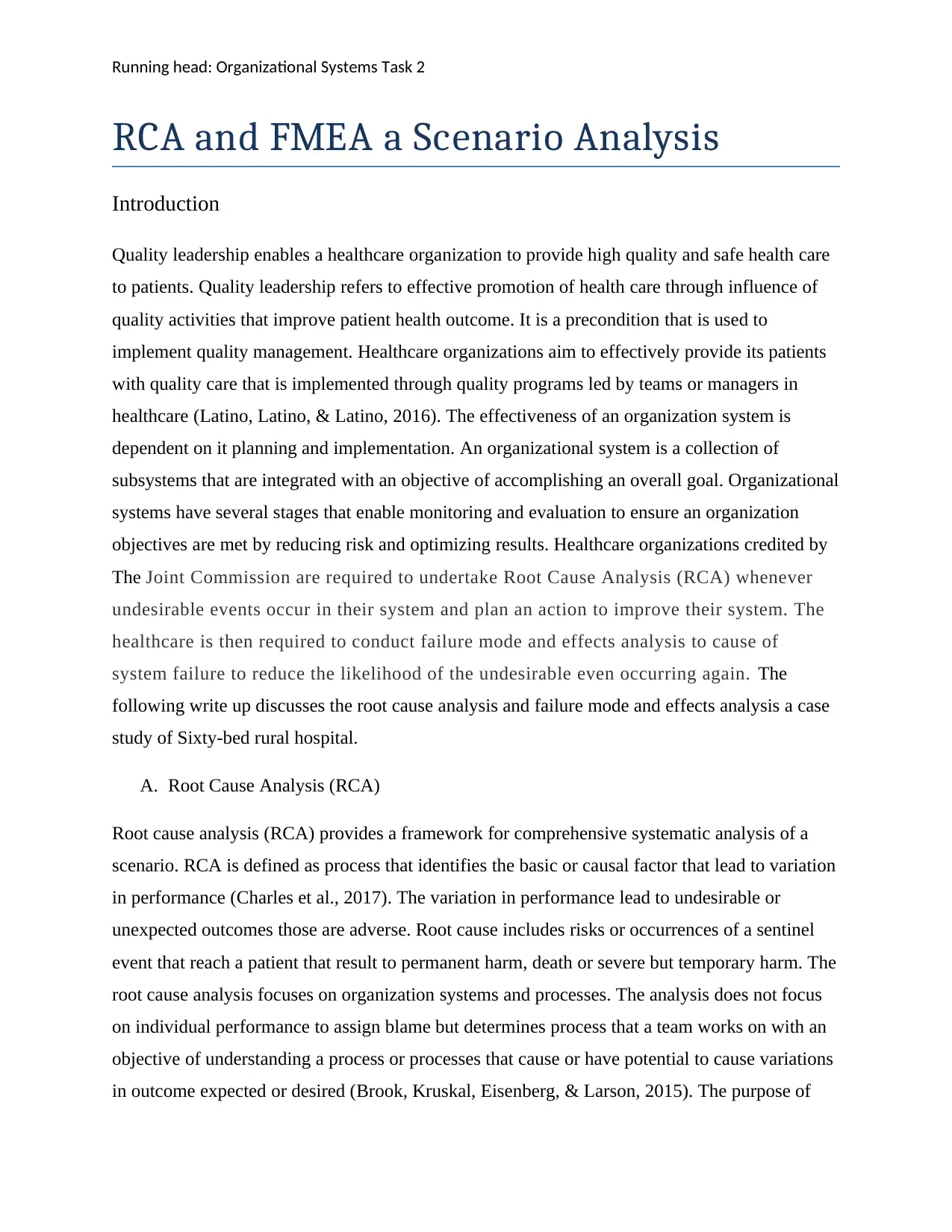
Running head: Organizational Systems Task 2
RCA and FMEA a Scenario Analysis
Introduction
Quality leadership enables a healthcare organization to provide high quality and safe health care
to patients. Quality leadership refers to effective promotion of health care through influence of
quality activities that improve patient health outcome. It is a precondition that is used to
implement quality management. Healthcare organizations aim to effectively provide its patients
with quality care that is implemented through quality programs led by teams or managers in
healthcare (Latino, Latino, & Latino, 2016). The effectiveness of an organization system is
dependent on it planning and implementation. An organizational system is a collection of
subsystems that are integrated with an objective of accomplishing an overall goal. Organizational
systems have several stages that enable monitoring and evaluation to ensure an organization
objectives are met by reducing risk and optimizing results. Healthcare organizations credited by
The Joint Commission are required to undertake Root Cause Analysis (RCA) whenever
undesirable events occur in their system and plan an action to improve their system. The
healthcare is then required to conduct failure mode and effects analysis to cause of
system failure to reduce the likelihood of the undesirable even occurring again. The
following write up discusses the root cause analysis and failure mode and effects analysis a case
study of Sixty-bed rural hospital.
A. Root Cause Analysis (RCA)
Root cause analysis (RCA) provides a framework for comprehensive systematic analysis of a
scenario. RCA is defined as process that identifies the basic or causal factor that lead to variation
in performance (Charles et al., 2017). The variation in performance lead to undesirable or
unexpected outcomes those are adverse. Root cause includes risks or occurrences of a sentinel
event that reach a patient that result to permanent harm, death or severe but temporary harm. The
root cause analysis focuses on organization systems and processes. The analysis does not focus
on individual performance to assign blame but determines process that a team works on with an
objective of understanding a process or processes that cause or have potential to cause variations
in outcome expected or desired (Brook, Kruskal, Eisenberg, & Larson, 2015). The purpose of
RCA and FMEA a Scenario Analysis
Introduction
Quality leadership enables a healthcare organization to provide high quality and safe health care
to patients. Quality leadership refers to effective promotion of health care through influence of
quality activities that improve patient health outcome. It is a precondition that is used to
implement quality management. Healthcare organizations aim to effectively provide its patients
with quality care that is implemented through quality programs led by teams or managers in
healthcare (Latino, Latino, & Latino, 2016). The effectiveness of an organization system is
dependent on it planning and implementation. An organizational system is a collection of
subsystems that are integrated with an objective of accomplishing an overall goal. Organizational
systems have several stages that enable monitoring and evaluation to ensure an organization
objectives are met by reducing risk and optimizing results. Healthcare organizations credited by
The Joint Commission are required to undertake Root Cause Analysis (RCA) whenever
undesirable events occur in their system and plan an action to improve their system. The
healthcare is then required to conduct failure mode and effects analysis to cause of
system failure to reduce the likelihood of the undesirable even occurring again. The
following write up discusses the root cause analysis and failure mode and effects analysis a case
study of Sixty-bed rural hospital.
A. Root Cause Analysis (RCA)
Root cause analysis (RCA) provides a framework for comprehensive systematic analysis of a
scenario. RCA is defined as process that identifies the basic or causal factor that lead to variation
in performance (Charles et al., 2017). The variation in performance lead to undesirable or
unexpected outcomes those are adverse. Root cause includes risks or occurrences of a sentinel
event that reach a patient that result to permanent harm, death or severe but temporary harm. The
root cause analysis focuses on organization systems and processes. The analysis does not focus
on individual performance to assign blame but determines process that a team works on with an
objective of understanding a process or processes that cause or have potential to cause variations
in outcome expected or desired (Brook, Kruskal, Eisenberg, & Larson, 2015). The purpose of
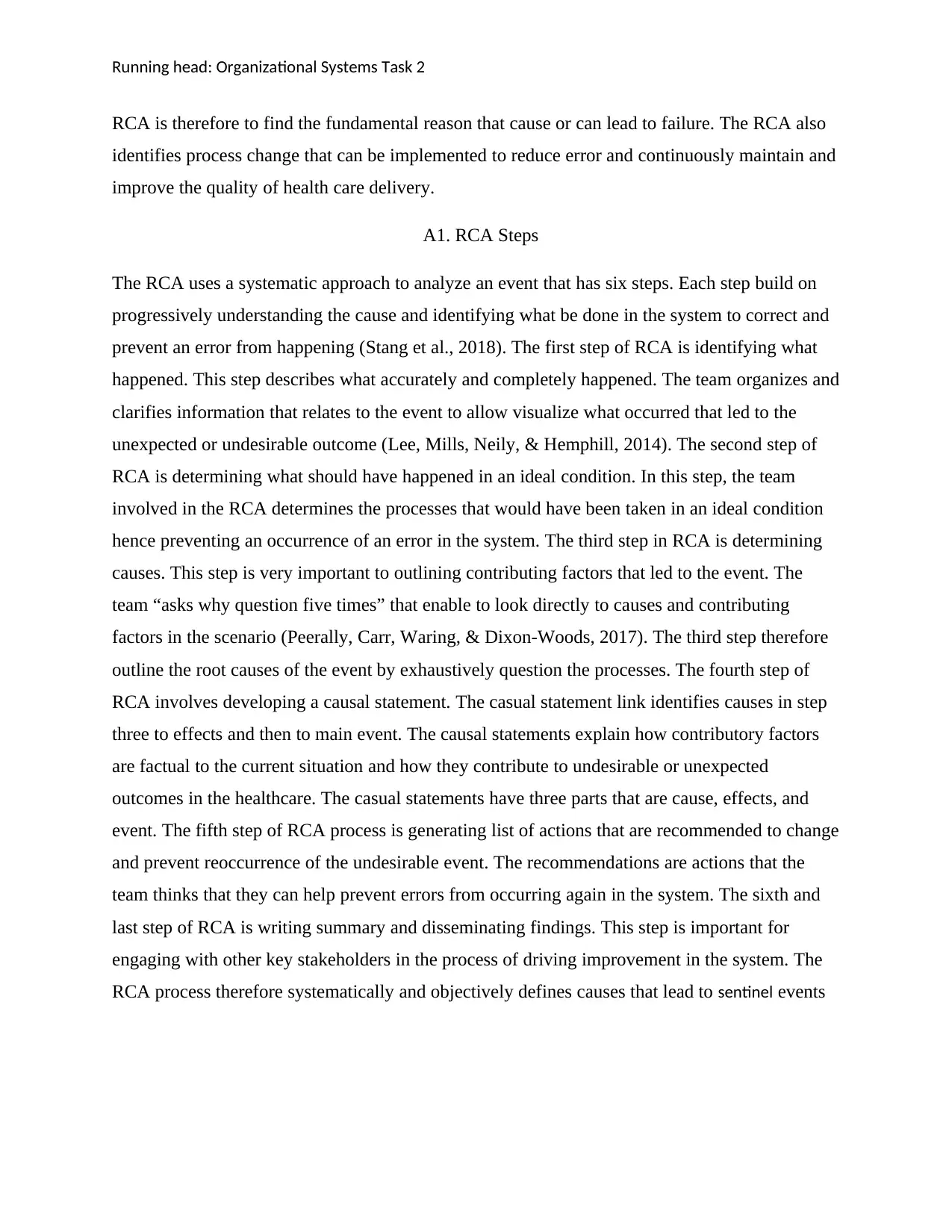
Running head: Organizational Systems Task 2
RCA is therefore to find the fundamental reason that cause or can lead to failure. The RCA also
identifies process change that can be implemented to reduce error and continuously maintain and
improve the quality of health care delivery.
A1. RCA Steps
The RCA uses a systematic approach to analyze an event that has six steps. Each step build on
progressively understanding the cause and identifying what be done in the system to correct and
prevent an error from happening (Stang et al., 2018). The first step of RCA is identifying what
happened. This step describes what accurately and completely happened. The team organizes and
clarifies information that relates to the event to allow visualize what occurred that led to the
unexpected or undesirable outcome (Lee, Mills, Neily, & Hemphill, 2014). The second step of
RCA is determining what should have happened in an ideal condition. In this step, the team
involved in the RCA determines the processes that would have been taken in an ideal condition
hence preventing an occurrence of an error in the system. The third step in RCA is determining
causes. This step is very important to outlining contributing factors that led to the event. The
team “asks why question five times” that enable to look directly to causes and contributing
factors in the scenario (Peerally, Carr, Waring, & Dixon-Woods, 2017). The third step therefore
outline the root causes of the event by exhaustively question the processes. The fourth step of
RCA involves developing a causal statement. The casual statement link identifies causes in step
three to effects and then to main event. The causal statements explain how contributory factors
are factual to the current situation and how they contribute to undesirable or unexpected
outcomes in the healthcare. The casual statements have three parts that are cause, effects, and
event. The fifth step of RCA process is generating list of actions that are recommended to change
and prevent reoccurrence of the undesirable event. The recommendations are actions that the
team thinks that they can help prevent errors from occurring again in the system. The sixth and
last step of RCA is writing summary and disseminating findings. This step is important for
engaging with other key stakeholders in the process of driving improvement in the system. The
RCA process therefore systematically and objectively defines causes that lead to sentinel events
RCA is therefore to find the fundamental reason that cause or can lead to failure. The RCA also
identifies process change that can be implemented to reduce error and continuously maintain and
improve the quality of health care delivery.
A1. RCA Steps
The RCA uses a systematic approach to analyze an event that has six steps. Each step build on
progressively understanding the cause and identifying what be done in the system to correct and
prevent an error from happening (Stang et al., 2018). The first step of RCA is identifying what
happened. This step describes what accurately and completely happened. The team organizes and
clarifies information that relates to the event to allow visualize what occurred that led to the
unexpected or undesirable outcome (Lee, Mills, Neily, & Hemphill, 2014). The second step of
RCA is determining what should have happened in an ideal condition. In this step, the team
involved in the RCA determines the processes that would have been taken in an ideal condition
hence preventing an occurrence of an error in the system. The third step in RCA is determining
causes. This step is very important to outlining contributing factors that led to the event. The
team “asks why question five times” that enable to look directly to causes and contributing
factors in the scenario (Peerally, Carr, Waring, & Dixon-Woods, 2017). The third step therefore
outline the root causes of the event by exhaustively question the processes. The fourth step of
RCA involves developing a causal statement. The casual statement link identifies causes in step
three to effects and then to main event. The causal statements explain how contributory factors
are factual to the current situation and how they contribute to undesirable or unexpected
outcomes in the healthcare. The casual statements have three parts that are cause, effects, and
event. The fifth step of RCA process is generating list of actions that are recommended to change
and prevent reoccurrence of the undesirable event. The recommendations are actions that the
team thinks that they can help prevent errors from occurring again in the system. The sixth and
last step of RCA is writing summary and disseminating findings. This step is important for
engaging with other key stakeholders in the process of driving improvement in the system. The
RCA process therefore systematically and objectively defines causes that lead to sentinel events
⊘ This is a preview!⊘
Do you want full access?
Subscribe today to unlock all pages.

Trusted by 1+ million students worldwide
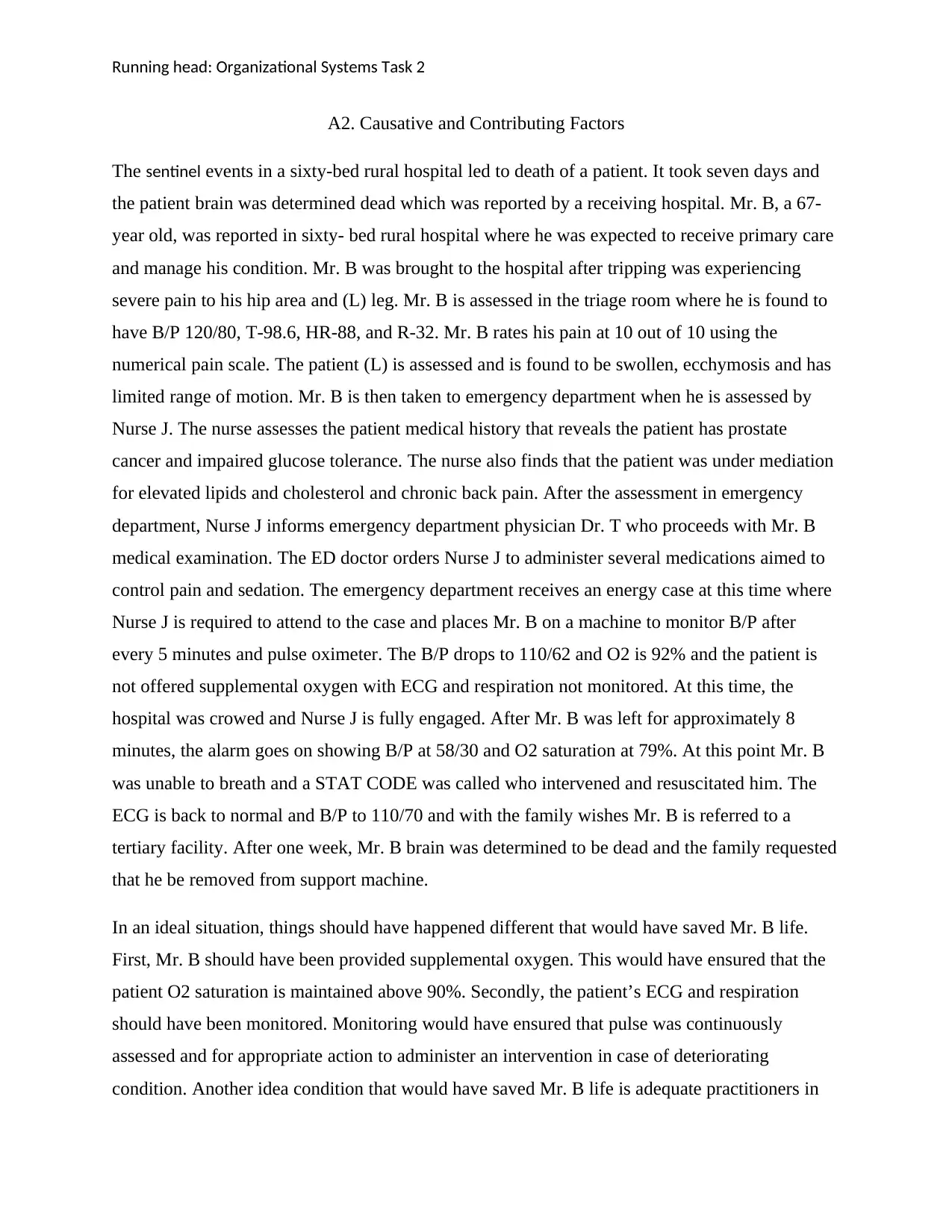
Running head: Organizational Systems Task 2
A2. Causative and Contributing Factors
The sentinel events in a sixty-bed rural hospital led to death of a patient. It took seven days and
the patient brain was determined dead which was reported by a receiving hospital. Mr. B, a 67-
year old, was reported in sixty- bed rural hospital where he was expected to receive primary care
and manage his condition. Mr. B was brought to the hospital after tripping was experiencing
severe pain to his hip area and (L) leg. Mr. B is assessed in the triage room where he is found to
have B/P 120/80, T-98.6, HR-88, and R-32. Mr. B rates his pain at 10 out of 10 using the
numerical pain scale. The patient (L) is assessed and is found to be swollen, ecchymosis and has
limited range of motion. Mr. B is then taken to emergency department when he is assessed by
Nurse J. The nurse assesses the patient medical history that reveals the patient has prostate
cancer and impaired glucose tolerance. The nurse also finds that the patient was under mediation
for elevated lipids and cholesterol and chronic back pain. After the assessment in emergency
department, Nurse J informs emergency department physician Dr. T who proceeds with Mr. B
medical examination. The ED doctor orders Nurse J to administer several medications aimed to
control pain and sedation. The emergency department receives an energy case at this time where
Nurse J is required to attend to the case and places Mr. B on a machine to monitor B/P after
every 5 minutes and pulse oximeter. The B/P drops to 110/62 and O2 is 92% and the patient is
not offered supplemental oxygen with ECG and respiration not monitored. At this time, the
hospital was crowed and Nurse J is fully engaged. After Mr. B was left for approximately 8
minutes, the alarm goes on showing B/P at 58/30 and O2 saturation at 79%. At this point Mr. B
was unable to breath and a STAT CODE was called who intervened and resuscitated him. The
ECG is back to normal and B/P to 110/70 and with the family wishes Mr. B is referred to a
tertiary facility. After one week, Mr. B brain was determined to be dead and the family requested
that he be removed from support machine.
In an ideal situation, things should have happened different that would have saved Mr. B life.
First, Mr. B should have been provided supplemental oxygen. This would have ensured that the
patient O2 saturation is maintained above 90%. Secondly, the patient’s ECG and respiration
should have been monitored. Monitoring would have ensured that pulse was continuously
assessed and for appropriate action to administer an intervention in case of deteriorating
condition. Another idea condition that would have saved Mr. B life is adequate practitioners in
A2. Causative and Contributing Factors
The sentinel events in a sixty-bed rural hospital led to death of a patient. It took seven days and
the patient brain was determined dead which was reported by a receiving hospital. Mr. B, a 67-
year old, was reported in sixty- bed rural hospital where he was expected to receive primary care
and manage his condition. Mr. B was brought to the hospital after tripping was experiencing
severe pain to his hip area and (L) leg. Mr. B is assessed in the triage room where he is found to
have B/P 120/80, T-98.6, HR-88, and R-32. Mr. B rates his pain at 10 out of 10 using the
numerical pain scale. The patient (L) is assessed and is found to be swollen, ecchymosis and has
limited range of motion. Mr. B is then taken to emergency department when he is assessed by
Nurse J. The nurse assesses the patient medical history that reveals the patient has prostate
cancer and impaired glucose tolerance. The nurse also finds that the patient was under mediation
for elevated lipids and cholesterol and chronic back pain. After the assessment in emergency
department, Nurse J informs emergency department physician Dr. T who proceeds with Mr. B
medical examination. The ED doctor orders Nurse J to administer several medications aimed to
control pain and sedation. The emergency department receives an energy case at this time where
Nurse J is required to attend to the case and places Mr. B on a machine to monitor B/P after
every 5 minutes and pulse oximeter. The B/P drops to 110/62 and O2 is 92% and the patient is
not offered supplemental oxygen with ECG and respiration not monitored. At this time, the
hospital was crowed and Nurse J is fully engaged. After Mr. B was left for approximately 8
minutes, the alarm goes on showing B/P at 58/30 and O2 saturation at 79%. At this point Mr. B
was unable to breath and a STAT CODE was called who intervened and resuscitated him. The
ECG is back to normal and B/P to 110/70 and with the family wishes Mr. B is referred to a
tertiary facility. After one week, Mr. B brain was determined to be dead and the family requested
that he be removed from support machine.
In an ideal situation, things should have happened different that would have saved Mr. B life.
First, Mr. B should have been provided supplemental oxygen. This would have ensured that the
patient O2 saturation is maintained above 90%. Secondly, the patient’s ECG and respiration
should have been monitored. Monitoring would have ensured that pulse was continuously
assessed and for appropriate action to administer an intervention in case of deteriorating
condition. Another idea condition that would have saved Mr. B life is adequate practitioners in
Paraphrase This Document
Need a fresh take? Get an instant paraphrase of this document with our AI Paraphraser
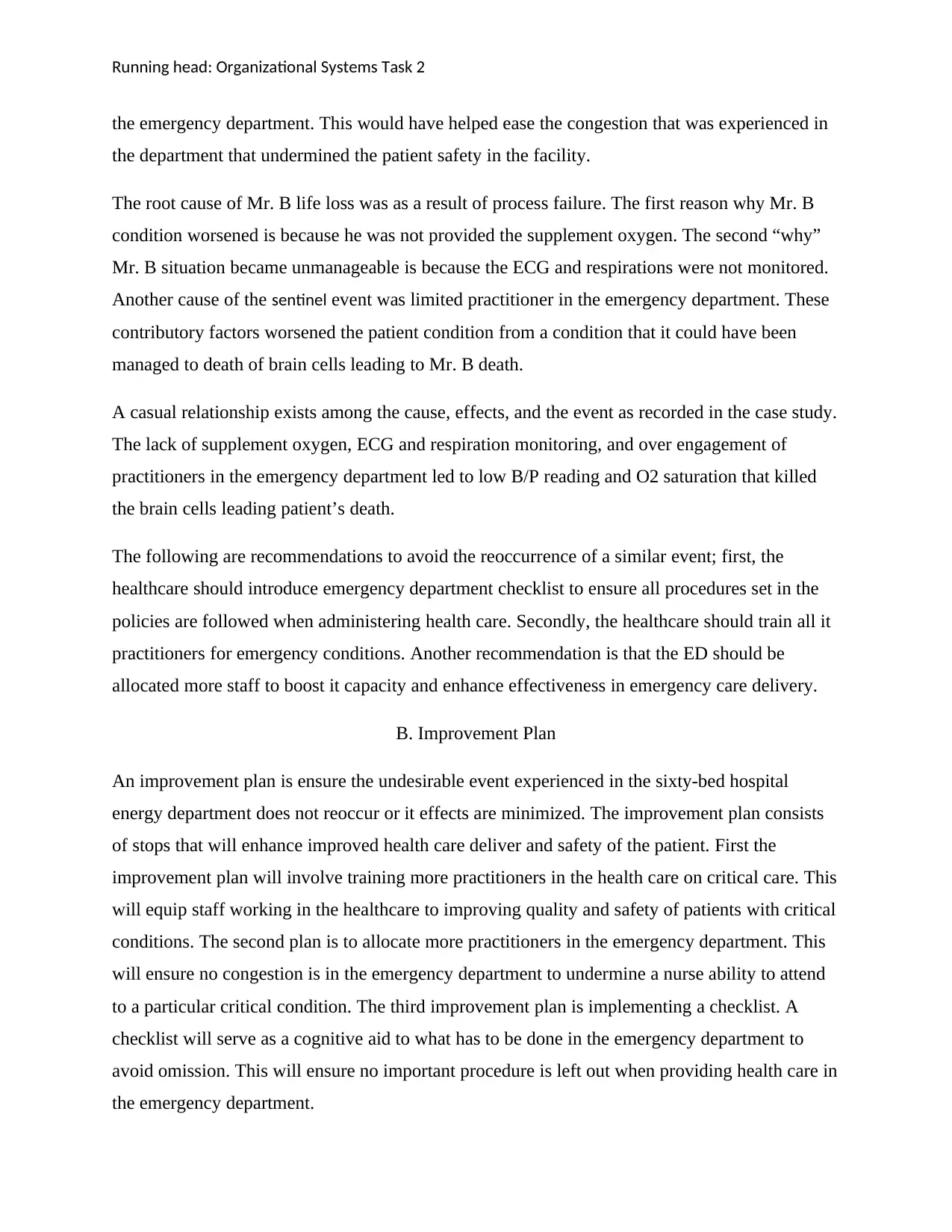
Running head: Organizational Systems Task 2
the emergency department. This would have helped ease the congestion that was experienced in
the department that undermined the patient safety in the facility.
The root cause of Mr. B life loss was as a result of process failure. The first reason why Mr. B
condition worsened is because he was not provided the supplement oxygen. The second “why”
Mr. B situation became unmanageable is because the ECG and respirations were not monitored.
Another cause of the sentinel event was limited practitioner in the emergency department. These
contributory factors worsened the patient condition from a condition that it could have been
managed to death of brain cells leading to Mr. B death.
A casual relationship exists among the cause, effects, and the event as recorded in the case study.
The lack of supplement oxygen, ECG and respiration monitoring, and over engagement of
practitioners in the emergency department led to low B/P reading and O2 saturation that killed
the brain cells leading patient’s death.
The following are recommendations to avoid the reoccurrence of a similar event; first, the
healthcare should introduce emergency department checklist to ensure all procedures set in the
policies are followed when administering health care. Secondly, the healthcare should train all it
practitioners for emergency conditions. Another recommendation is that the ED should be
allocated more staff to boost it capacity and enhance effectiveness in emergency care delivery.
B. Improvement Plan
An improvement plan is ensure the undesirable event experienced in the sixty-bed hospital
energy department does not reoccur or it effects are minimized. The improvement plan consists
of stops that will enhance improved health care deliver and safety of the patient. First the
improvement plan will involve training more practitioners in the health care on critical care. This
will equip staff working in the healthcare to improving quality and safety of patients with critical
conditions. The second plan is to allocate more practitioners in the emergency department. This
will ensure no congestion is in the emergency department to undermine a nurse ability to attend
to a particular critical condition. The third improvement plan is implementing a checklist. A
checklist will serve as a cognitive aid to what has to be done in the emergency department to
avoid omission. This will ensure no important procedure is left out when providing health care in
the emergency department.
the emergency department. This would have helped ease the congestion that was experienced in
the department that undermined the patient safety in the facility.
The root cause of Mr. B life loss was as a result of process failure. The first reason why Mr. B
condition worsened is because he was not provided the supplement oxygen. The second “why”
Mr. B situation became unmanageable is because the ECG and respirations were not monitored.
Another cause of the sentinel event was limited practitioner in the emergency department. These
contributory factors worsened the patient condition from a condition that it could have been
managed to death of brain cells leading to Mr. B death.
A casual relationship exists among the cause, effects, and the event as recorded in the case study.
The lack of supplement oxygen, ECG and respiration monitoring, and over engagement of
practitioners in the emergency department led to low B/P reading and O2 saturation that killed
the brain cells leading patient’s death.
The following are recommendations to avoid the reoccurrence of a similar event; first, the
healthcare should introduce emergency department checklist to ensure all procedures set in the
policies are followed when administering health care. Secondly, the healthcare should train all it
practitioners for emergency conditions. Another recommendation is that the ED should be
allocated more staff to boost it capacity and enhance effectiveness in emergency care delivery.
B. Improvement Plan
An improvement plan is ensure the undesirable event experienced in the sixty-bed hospital
energy department does not reoccur or it effects are minimized. The improvement plan consists
of stops that will enhance improved health care deliver and safety of the patient. First the
improvement plan will involve training more practitioners in the health care on critical care. This
will equip staff working in the healthcare to improving quality and safety of patients with critical
conditions. The second plan is to allocate more practitioners in the emergency department. This
will ensure no congestion is in the emergency department to undermine a nurse ability to attend
to a particular critical condition. The third improvement plan is implementing a checklist. A
checklist will serve as a cognitive aid to what has to be done in the emergency department to
avoid omission. This will ensure no important procedure is left out when providing health care in
the emergency department.
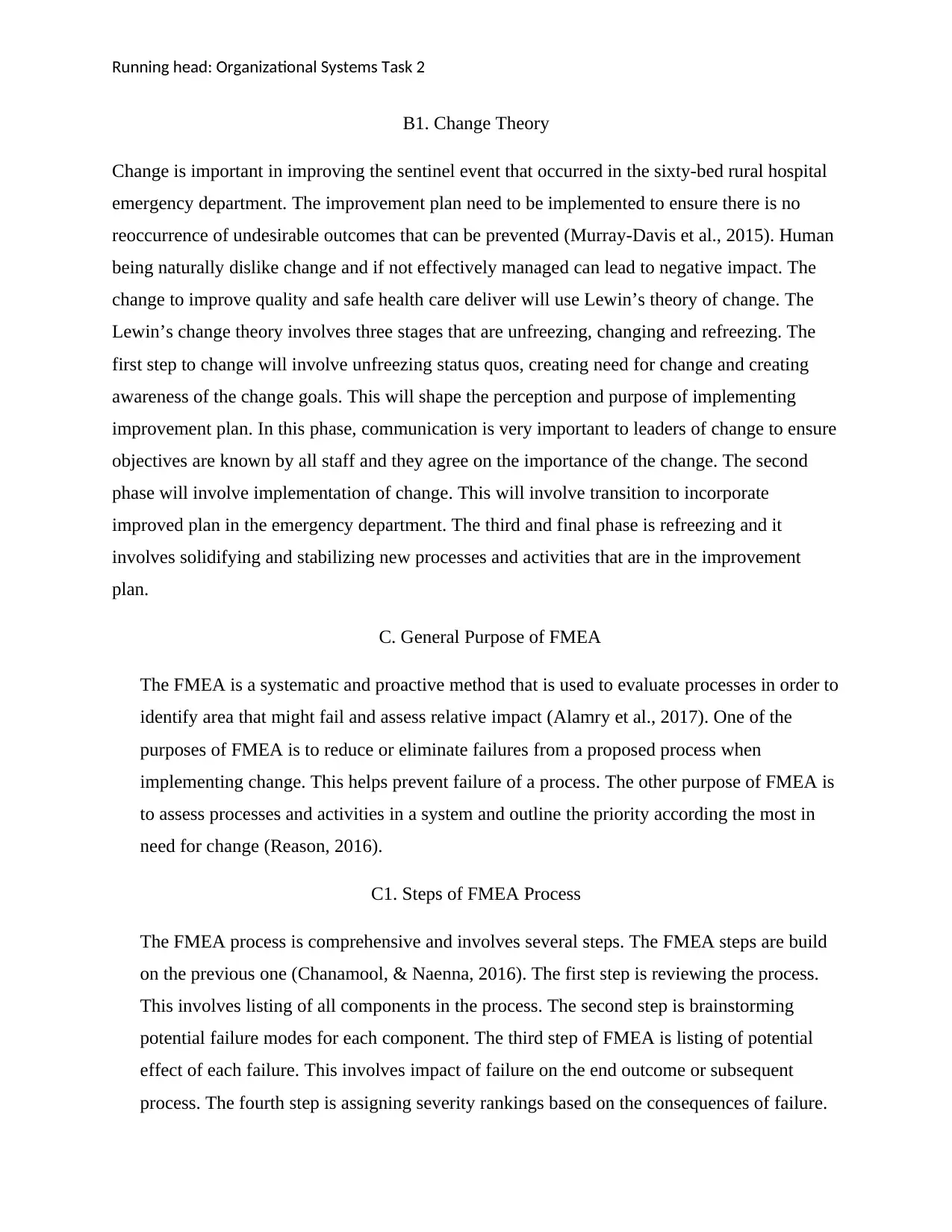
Running head: Organizational Systems Task 2
B1. Change Theory
Change is important in improving the sentinel event that occurred in the sixty-bed rural hospital
emergency department. The improvement plan need to be implemented to ensure there is no
reoccurrence of undesirable outcomes that can be prevented (Murray-Davis et al., 2015). Human
being naturally dislike change and if not effectively managed can lead to negative impact. The
change to improve quality and safe health care deliver will use Lewin’s theory of change. The
Lewin’s change theory involves three stages that are unfreezing, changing and refreezing. The
first step to change will involve unfreezing status quos, creating need for change and creating
awareness of the change goals. This will shape the perception and purpose of implementing
improvement plan. In this phase, communication is very important to leaders of change to ensure
objectives are known by all staff and they agree on the importance of the change. The second
phase will involve implementation of change. This will involve transition to incorporate
improved plan in the emergency department. The third and final phase is refreezing and it
involves solidifying and stabilizing new processes and activities that are in the improvement
plan.
C. General Purpose of FMEA
The FMEA is a systematic and proactive method that is used to evaluate processes in order to
identify area that might fail and assess relative impact (Alamry et al., 2017). One of the
purposes of FMEA is to reduce or eliminate failures from a proposed process when
implementing change. This helps prevent failure of a process. The other purpose of FMEA is
to assess processes and activities in a system and outline the priority according the most in
need for change (Reason, 2016).
C1. Steps of FMEA Process
The FMEA process is comprehensive and involves several steps. The FMEA steps are build
on the previous one (Chanamool, & Naenna, 2016). The first step is reviewing the process.
This involves listing of all components in the process. The second step is brainstorming
potential failure modes for each component. The third step of FMEA is listing of potential
effect of each failure. This involves impact of failure on the end outcome or subsequent
process. The fourth step is assigning severity rankings based on the consequences of failure.
B1. Change Theory
Change is important in improving the sentinel event that occurred in the sixty-bed rural hospital
emergency department. The improvement plan need to be implemented to ensure there is no
reoccurrence of undesirable outcomes that can be prevented (Murray-Davis et al., 2015). Human
being naturally dislike change and if not effectively managed can lead to negative impact. The
change to improve quality and safe health care deliver will use Lewin’s theory of change. The
Lewin’s change theory involves three stages that are unfreezing, changing and refreezing. The
first step to change will involve unfreezing status quos, creating need for change and creating
awareness of the change goals. This will shape the perception and purpose of implementing
improvement plan. In this phase, communication is very important to leaders of change to ensure
objectives are known by all staff and they agree on the importance of the change. The second
phase will involve implementation of change. This will involve transition to incorporate
improved plan in the emergency department. The third and final phase is refreezing and it
involves solidifying and stabilizing new processes and activities that are in the improvement
plan.
C. General Purpose of FMEA
The FMEA is a systematic and proactive method that is used to evaluate processes in order to
identify area that might fail and assess relative impact (Alamry et al., 2017). One of the
purposes of FMEA is to reduce or eliminate failures from a proposed process when
implementing change. This helps prevent failure of a process. The other purpose of FMEA is
to assess processes and activities in a system and outline the priority according the most in
need for change (Reason, 2016).
C1. Steps of FMEA Process
The FMEA process is comprehensive and involves several steps. The FMEA steps are build
on the previous one (Chanamool, & Naenna, 2016). The first step is reviewing the process.
This involves listing of all components in the process. The second step is brainstorming
potential failure modes for each component. The third step of FMEA is listing of potential
effect of each failure. This involves impact of failure on the end outcome or subsequent
process. The fourth step is assigning severity rankings based on the consequences of failure.
⊘ This is a preview!⊘
Do you want full access?
Subscribe today to unlock all pages.

Trusted by 1+ million students worldwide
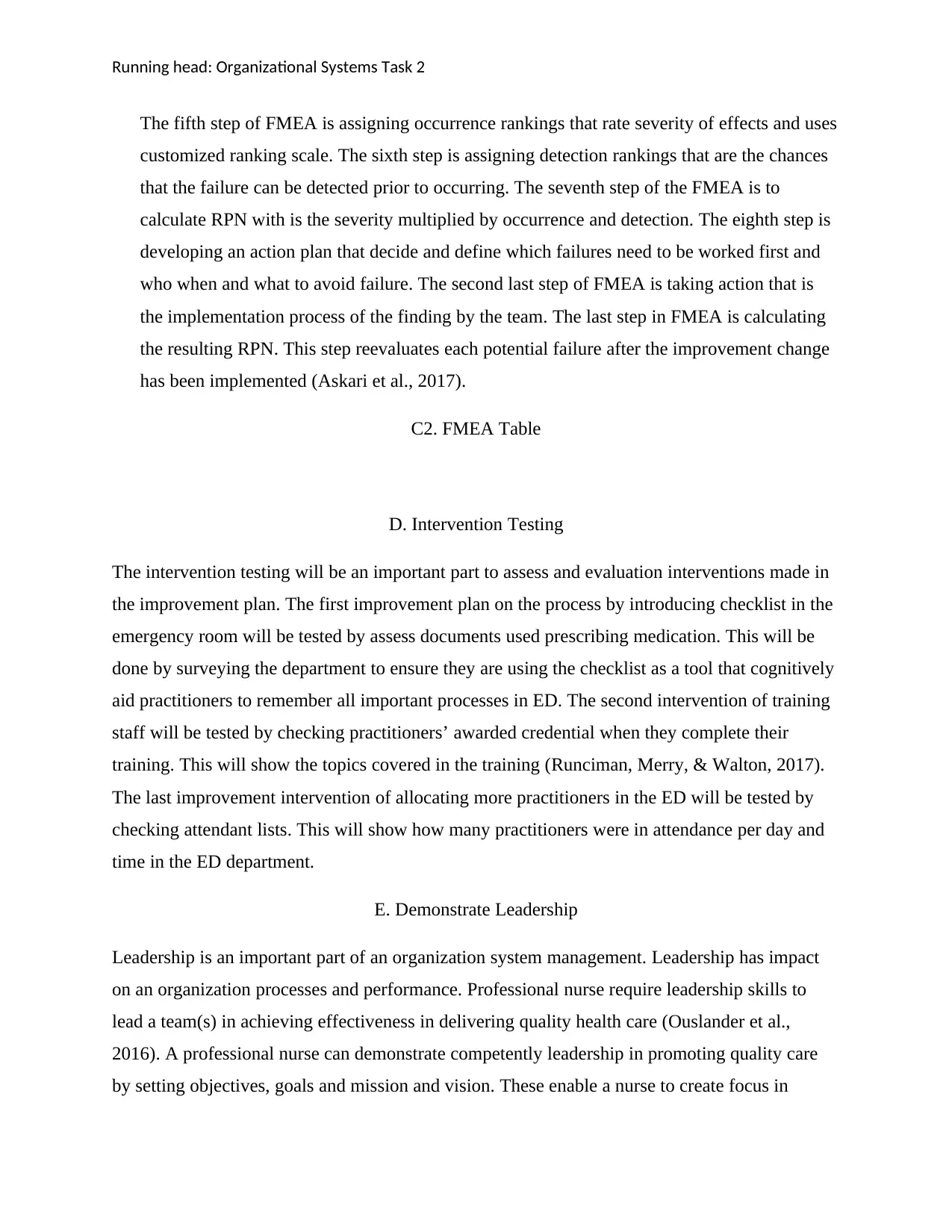
Running head: Organizational Systems Task 2
The fifth step of FMEA is assigning occurrence rankings that rate severity of effects and uses
customized ranking scale. The sixth step is assigning detection rankings that are the chances
that the failure can be detected prior to occurring. The seventh step of the FMEA is to
calculate RPN with is the severity multiplied by occurrence and detection. The eighth step is
developing an action plan that decide and define which failures need to be worked first and
who when and what to avoid failure. The second last step of FMEA is taking action that is
the implementation process of the finding by the team. The last step in FMEA is calculating
the resulting RPN. This step reevaluates each potential failure after the improvement change
has been implemented (Askari et al., 2017).
C2. FMEA Table
D. Intervention Testing
The intervention testing will be an important part to assess and evaluation interventions made in
the improvement plan. The first improvement plan on the process by introducing checklist in the
emergency room will be tested by assess documents used prescribing medication. This will be
done by surveying the department to ensure they are using the checklist as a tool that cognitively
aid practitioners to remember all important processes in ED. The second intervention of training
staff will be tested by checking practitioners’ awarded credential when they complete their
training. This will show the topics covered in the training (Runciman, Merry, & Walton, 2017).
The last improvement intervention of allocating more practitioners in the ED will be tested by
checking attendant lists. This will show how many practitioners were in attendance per day and
time in the ED department.
E. Demonstrate Leadership
Leadership is an important part of an organization system management. Leadership has impact
on an organization processes and performance. Professional nurse require leadership skills to
lead a team(s) in achieving effectiveness in delivering quality health care (Ouslander et al.,
2016). A professional nurse can demonstrate competently leadership in promoting quality care
by setting objectives, goals and mission and vision. These enable a nurse to create focus in
The fifth step of FMEA is assigning occurrence rankings that rate severity of effects and uses
customized ranking scale. The sixth step is assigning detection rankings that are the chances
that the failure can be detected prior to occurring. The seventh step of the FMEA is to
calculate RPN with is the severity multiplied by occurrence and detection. The eighth step is
developing an action plan that decide and define which failures need to be worked first and
who when and what to avoid failure. The second last step of FMEA is taking action that is
the implementation process of the finding by the team. The last step in FMEA is calculating
the resulting RPN. This step reevaluates each potential failure after the improvement change
has been implemented (Askari et al., 2017).
C2. FMEA Table
D. Intervention Testing
The intervention testing will be an important part to assess and evaluation interventions made in
the improvement plan. The first improvement plan on the process by introducing checklist in the
emergency room will be tested by assess documents used prescribing medication. This will be
done by surveying the department to ensure they are using the checklist as a tool that cognitively
aid practitioners to remember all important processes in ED. The second intervention of training
staff will be tested by checking practitioners’ awarded credential when they complete their
training. This will show the topics covered in the training (Runciman, Merry, & Walton, 2017).
The last improvement intervention of allocating more practitioners in the ED will be tested by
checking attendant lists. This will show how many practitioners were in attendance per day and
time in the ED department.
E. Demonstrate Leadership
Leadership is an important part of an organization system management. Leadership has impact
on an organization processes and performance. Professional nurse require leadership skills to
lead a team(s) in achieving effectiveness in delivering quality health care (Ouslander et al.,
2016). A professional nurse can demonstrate competently leadership in promoting quality care
by setting objectives, goals and mission and vision. These enable a nurse to create focus in
Paraphrase This Document
Need a fresh take? Get an instant paraphrase of this document with our AI Paraphraser
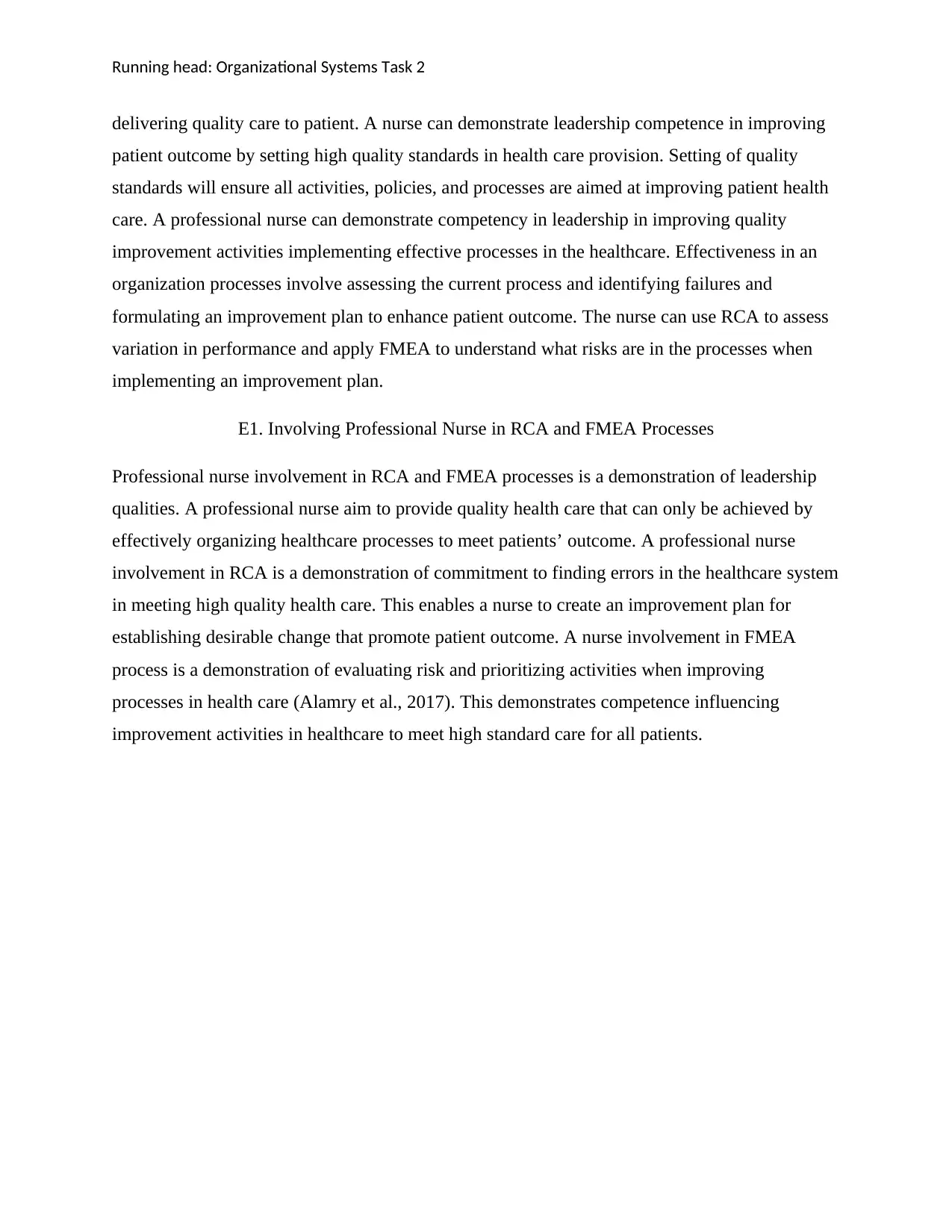
Running head: Organizational Systems Task 2
delivering quality care to patient. A nurse can demonstrate leadership competence in improving
patient outcome by setting high quality standards in health care provision. Setting of quality
standards will ensure all activities, policies, and processes are aimed at improving patient health
care. A professional nurse can demonstrate competency in leadership in improving quality
improvement activities implementing effective processes in the healthcare. Effectiveness in an
organization processes involve assessing the current process and identifying failures and
formulating an improvement plan to enhance patient outcome. The nurse can use RCA to assess
variation in performance and apply FMEA to understand what risks are in the processes when
implementing an improvement plan.
E1. Involving Professional Nurse in RCA and FMEA Processes
Professional nurse involvement in RCA and FMEA processes is a demonstration of leadership
qualities. A professional nurse aim to provide quality health care that can only be achieved by
effectively organizing healthcare processes to meet patients’ outcome. A professional nurse
involvement in RCA is a demonstration of commitment to finding errors in the healthcare system
in meeting high quality health care. This enables a nurse to create an improvement plan for
establishing desirable change that promote patient outcome. A nurse involvement in FMEA
process is a demonstration of evaluating risk and prioritizing activities when improving
processes in health care (Alamry et al., 2017). This demonstrates competence influencing
improvement activities in healthcare to meet high standard care for all patients.
delivering quality care to patient. A nurse can demonstrate leadership competence in improving
patient outcome by setting high quality standards in health care provision. Setting of quality
standards will ensure all activities, policies, and processes are aimed at improving patient health
care. A professional nurse can demonstrate competency in leadership in improving quality
improvement activities implementing effective processes in the healthcare. Effectiveness in an
organization processes involve assessing the current process and identifying failures and
formulating an improvement plan to enhance patient outcome. The nurse can use RCA to assess
variation in performance and apply FMEA to understand what risks are in the processes when
implementing an improvement plan.
E1. Involving Professional Nurse in RCA and FMEA Processes
Professional nurse involvement in RCA and FMEA processes is a demonstration of leadership
qualities. A professional nurse aim to provide quality health care that can only be achieved by
effectively organizing healthcare processes to meet patients’ outcome. A professional nurse
involvement in RCA is a demonstration of commitment to finding errors in the healthcare system
in meeting high quality health care. This enables a nurse to create an improvement plan for
establishing desirable change that promote patient outcome. A nurse involvement in FMEA
process is a demonstration of evaluating risk and prioritizing activities when improving
processes in health care (Alamry et al., 2017). This demonstrates competence influencing
improvement activities in healthcare to meet high standard care for all patients.
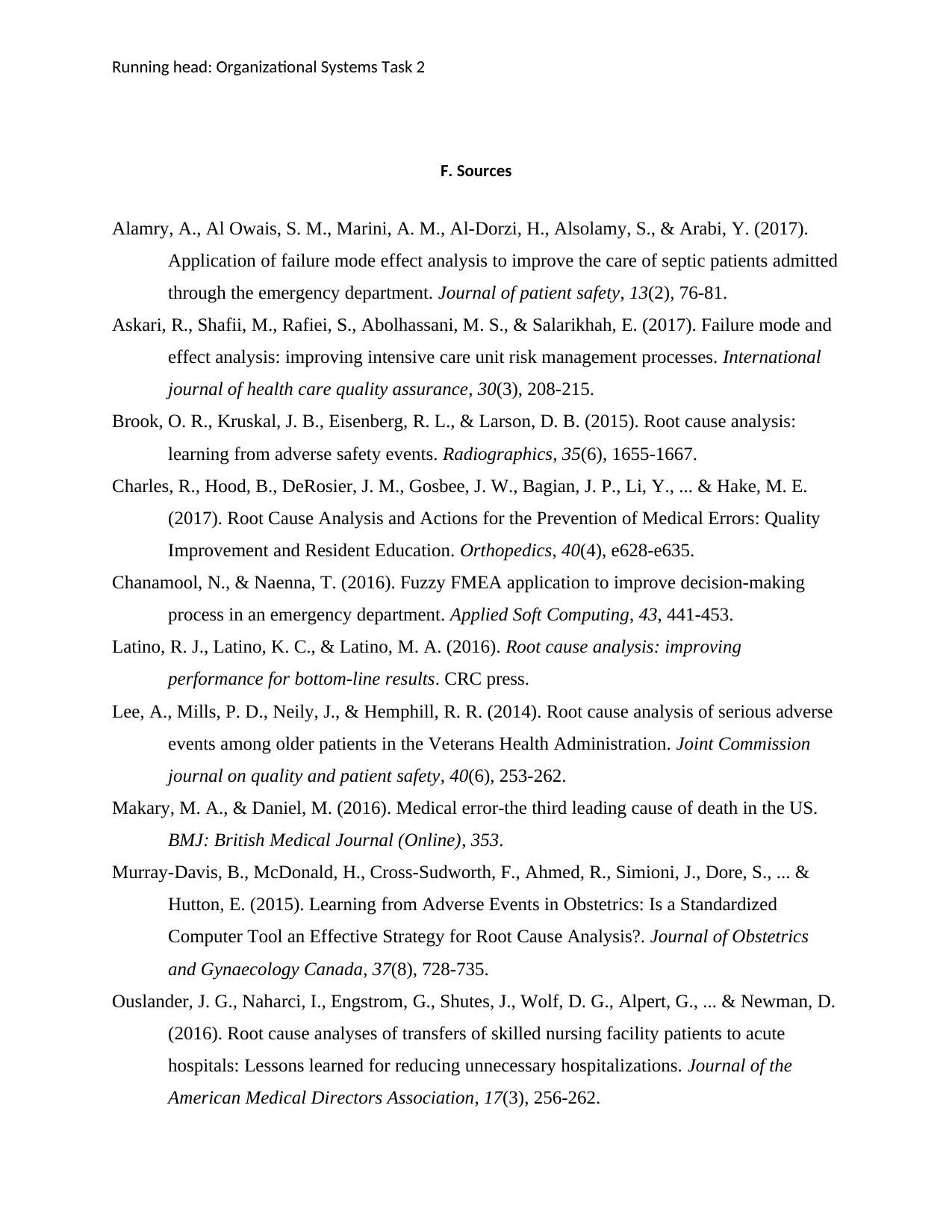
Running head: Organizational Systems Task 2
F. Sources
Alamry, A., Al Owais, S. M., Marini, A. M., Al-Dorzi, H., Alsolamy, S., & Arabi, Y. (2017).
Application of failure mode effect analysis to improve the care of septic patients admitted
through the emergency department. Journal of patient safety, 13(2), 76-81.
Askari, R., Shafii, M., Rafiei, S., Abolhassani, M. S., & Salarikhah, E. (2017). Failure mode and
effect analysis: improving intensive care unit risk management processes. International
journal of health care quality assurance, 30(3), 208-215.
Brook, O. R., Kruskal, J. B., Eisenberg, R. L., & Larson, D. B. (2015). Root cause analysis:
learning from adverse safety events. Radiographics, 35(6), 1655-1667.
Charles, R., Hood, B., DeRosier, J. M., Gosbee, J. W., Bagian, J. P., Li, Y., ... & Hake, M. E.
(2017). Root Cause Analysis and Actions for the Prevention of Medical Errors: Quality
Improvement and Resident Education. Orthopedics, 40(4), e628-e635.
Chanamool, N., & Naenna, T. (2016). Fuzzy FMEA application to improve decision-making
process in an emergency department. Applied Soft Computing, 43, 441-453.
Latino, R. J., Latino, K. C., & Latino, M. A. (2016). Root cause analysis: improving
performance for bottom-line results. CRC press.
Lee, A., Mills, P. D., Neily, J., & Hemphill, R. R. (2014). Root cause analysis of serious adverse
events among older patients in the Veterans Health Administration. Joint Commission
journal on quality and patient safety, 40(6), 253-262.
Makary, M. A., & Daniel, M. (2016). Medical error-the third leading cause of death in the US.
BMJ: British Medical Journal (Online), 353.
Murray-Davis, B., McDonald, H., Cross-Sudworth, F., Ahmed, R., Simioni, J., Dore, S., ... &
Hutton, E. (2015). Learning from Adverse Events in Obstetrics: Is a Standardized
Computer Tool an Effective Strategy for Root Cause Analysis?. Journal of Obstetrics
and Gynaecology Canada, 37(8), 728-735.
Ouslander, J. G., Naharci, I., Engstrom, G., Shutes, J., Wolf, D. G., Alpert, G., ... & Newman, D.
(2016). Root cause analyses of transfers of skilled nursing facility patients to acute
hospitals: Lessons learned for reducing unnecessary hospitalizations. Journal of the
American Medical Directors Association, 17(3), 256-262.
F. Sources
Alamry, A., Al Owais, S. M., Marini, A. M., Al-Dorzi, H., Alsolamy, S., & Arabi, Y. (2017).
Application of failure mode effect analysis to improve the care of septic patients admitted
through the emergency department. Journal of patient safety, 13(2), 76-81.
Askari, R., Shafii, M., Rafiei, S., Abolhassani, M. S., & Salarikhah, E. (2017). Failure mode and
effect analysis: improving intensive care unit risk management processes. International
journal of health care quality assurance, 30(3), 208-215.
Brook, O. R., Kruskal, J. B., Eisenberg, R. L., & Larson, D. B. (2015). Root cause analysis:
learning from adverse safety events. Radiographics, 35(6), 1655-1667.
Charles, R., Hood, B., DeRosier, J. M., Gosbee, J. W., Bagian, J. P., Li, Y., ... & Hake, M. E.
(2017). Root Cause Analysis and Actions for the Prevention of Medical Errors: Quality
Improvement and Resident Education. Orthopedics, 40(4), e628-e635.
Chanamool, N., & Naenna, T. (2016). Fuzzy FMEA application to improve decision-making
process in an emergency department. Applied Soft Computing, 43, 441-453.
Latino, R. J., Latino, K. C., & Latino, M. A. (2016). Root cause analysis: improving
performance for bottom-line results. CRC press.
Lee, A., Mills, P. D., Neily, J., & Hemphill, R. R. (2014). Root cause analysis of serious adverse
events among older patients in the Veterans Health Administration. Joint Commission
journal on quality and patient safety, 40(6), 253-262.
Makary, M. A., & Daniel, M. (2016). Medical error-the third leading cause of death in the US.
BMJ: British Medical Journal (Online), 353.
Murray-Davis, B., McDonald, H., Cross-Sudworth, F., Ahmed, R., Simioni, J., Dore, S., ... &
Hutton, E. (2015). Learning from Adverse Events in Obstetrics: Is a Standardized
Computer Tool an Effective Strategy for Root Cause Analysis?. Journal of Obstetrics
and Gynaecology Canada, 37(8), 728-735.
Ouslander, J. G., Naharci, I., Engstrom, G., Shutes, J., Wolf, D. G., Alpert, G., ... & Newman, D.
(2016). Root cause analyses of transfers of skilled nursing facility patients to acute
hospitals: Lessons learned for reducing unnecessary hospitalizations. Journal of the
American Medical Directors Association, 17(3), 256-262.
⊘ This is a preview!⊘
Do you want full access?
Subscribe today to unlock all pages.

Trusted by 1+ million students worldwide
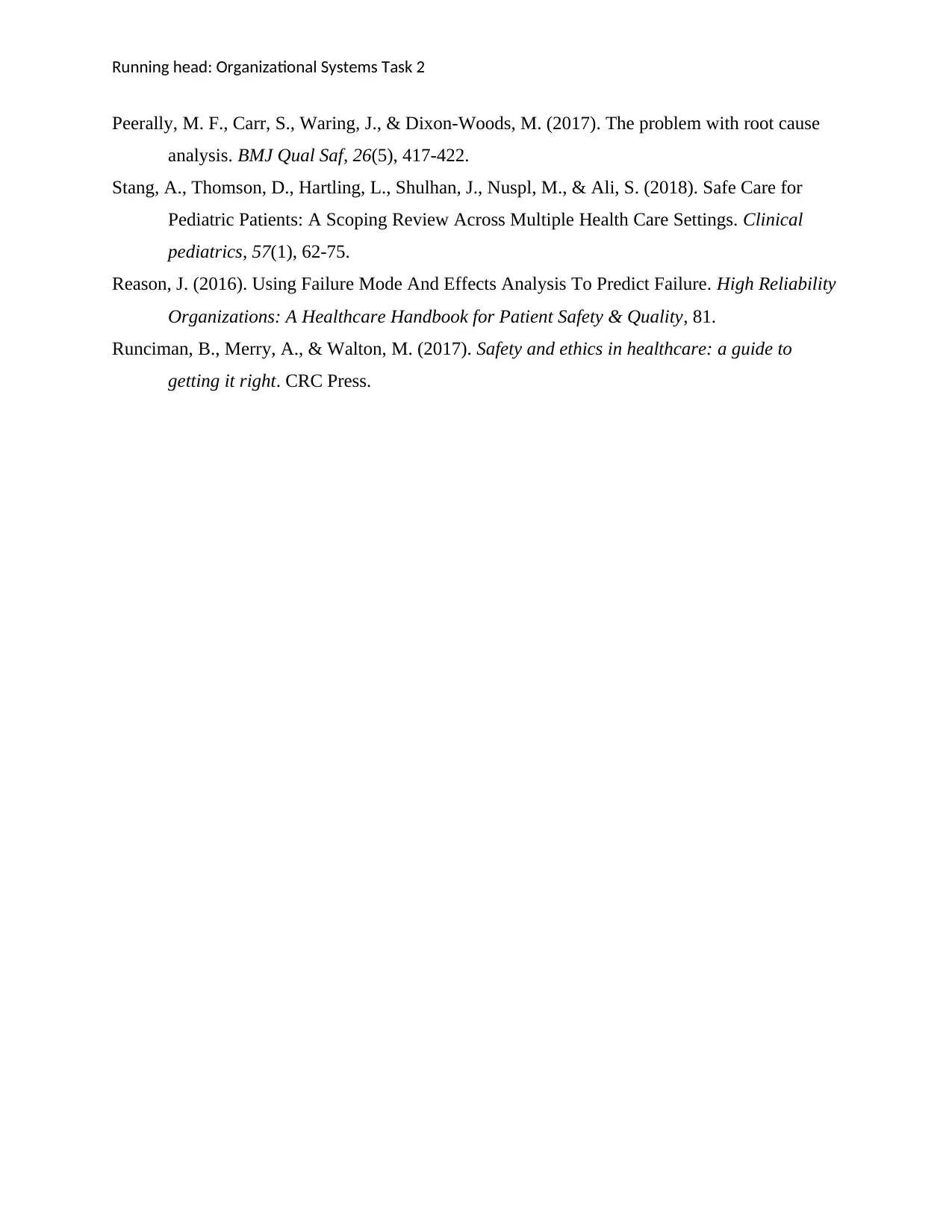
Running head: Organizational Systems Task 2
Peerally, M. F., Carr, S., Waring, J., & Dixon-Woods, M. (2017). The problem with root cause
analysis. BMJ Qual Saf, 26(5), 417-422.
Stang, A., Thomson, D., Hartling, L., Shulhan, J., Nuspl, M., & Ali, S. (2018). Safe Care for
Pediatric Patients: A Scoping Review Across Multiple Health Care Settings. Clinical
pediatrics, 57(1), 62-75.
Reason, J. (2016). Using Failure Mode And Effects Analysis To Predict Failure. High Reliability
Organizations: A Healthcare Handbook for Patient Safety & Quality, 81.
Runciman, B., Merry, A., & Walton, M. (2017). Safety and ethics in healthcare: a guide to
getting it right. CRC Press.
Peerally, M. F., Carr, S., Waring, J., & Dixon-Woods, M. (2017). The problem with root cause
analysis. BMJ Qual Saf, 26(5), 417-422.
Stang, A., Thomson, D., Hartling, L., Shulhan, J., Nuspl, M., & Ali, S. (2018). Safe Care for
Pediatric Patients: A Scoping Review Across Multiple Health Care Settings. Clinical
pediatrics, 57(1), 62-75.
Reason, J. (2016). Using Failure Mode And Effects Analysis To Predict Failure. High Reliability
Organizations: A Healthcare Handbook for Patient Safety & Quality, 81.
Runciman, B., Merry, A., & Walton, M. (2017). Safety and ethics in healthcare: a guide to
getting it right. CRC Press.
1 out of 10
Related Documents
Your All-in-One AI-Powered Toolkit for Academic Success.
+13062052269
info@desklib.com
Available 24*7 on WhatsApp / Email
![[object Object]](/_next/static/media/star-bottom.7253800d.svg)
Unlock your academic potential
Copyright © 2020–2025 A2Z Services. All Rights Reserved. Developed and managed by ZUCOL.





